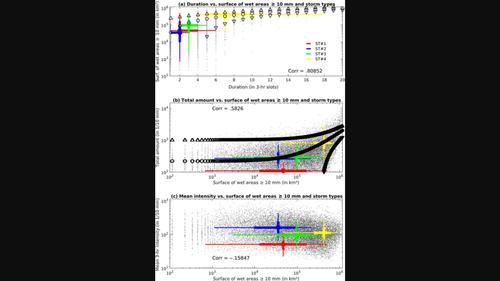当前位置:
X-MOL 学术
›
Int. J. Climatol.
›
论文详情
Our official English website, www.x-mol.net, welcomes your
feedback! (Note: you will need to create a separate account there.)
Storm types in Bangladesh: duration, intensity and area of intra-daily wet events
International Journal of Climatology ( IF 3.5 ) Pub Date : 2022-08-23 , DOI: 10.1002/joc.7835 Vincent Moron 1, 2 , Nachiketa Acharya 3, 4 , Quamrul SM Hassan 5
International Journal of Climatology ( IF 3.5 ) Pub Date : 2022-08-23 , DOI: 10.1002/joc.7835 Vincent Moron 1, 2 , Nachiketa Acharya 3, 4 , Quamrul SM Hassan 5
Affiliation

|
We explore the characteristics of 96,190 wet events (WEs) defined as consecutive 3-hourly rainfall ≥ 1 mm/3 hr from a network of 34 stations across Bangladesh. Nearly 60% (5%) of WEs last ≤ 3 (≥ 15) hr. The WEs are dynamically clustered into four “canonical” storm types (STs), mostly discretized by their duration, but also their mean and maximal intensity. While durations, total amounts and wet contiguous areas of WEs are positively related, their mean intensity is nearly independent of them. Approximately 60% of WEs are associated with ST#1, characterized by short and small WEs and very low rainfall amounts (usually <10 mm), ~30% of WEs are associated with either (ST#2) short/small WEs but with intense rainfall, probably mostly related to scattered thunderstorms or (ST#3) longer/larger WEs but with less intense rainfall. The last ST (ST#4) is rare (~6%), related to very long durations and large wet areas and includes the wettest WEs. It is especially frequent over southeastern Bangladesh. ST#2–ST#4 contribute almost equally to the local-scale total amount of rainfall (27–29% each in mean) while ST#1, despite its individual low rainfall amount, still includes ~15% of it. ST#2 (ST#4) is related to the highest probability of occurrence of 3-hourly (daily) extremes. ST#4 occurrence is the most impacted by synoptic Indian lows/depressions as well as the main modes of intra-seasonal variation, while ST#1 and ST#2 are also significantly impacted by intra-seasonal modes but in reverse manner than ST#4.
中文翻译:

孟加拉国的风暴类型:日内潮湿事件的持续时间、强度和面积
我们探索了来自孟加拉国 34 个站点网络的 96,190 个潮湿事件 (WE) 的特征,这些事件定义为连续 3 小时降雨量≥ 1 毫米/3 小时。近 60% (5%) 的 WEs 持续时间≤ 3 (≥ 15) 小时。WE 动态地聚集成四种“规范”风暴类型 (ST),主要按持续时间离散,但也按平均强度和最大强度离散。虽然 WE 的持续时间、总量和潮湿的连续区域呈正相关,但它们的平均强度几乎与它们无关。大约 60% 的 WE 与 ST#1 相关,其特点是短小的 WE 和极低的降雨量(通常 <10 毫米),约 30% 的 WE 与(ST#2)短/小 WE 相关,但与强降雨,可能主要与分散的雷暴或 (ST#3) 更长/更大的 WEs 但降雨强度较小有关。最后一个 ST (ST#4) 很少见 (~6%),与非常长的持续时间和大面积潮湿区域有关,并且包括最潮湿的 WE。它在孟加拉国东南部尤为频繁。ST#2–ST#4 对局部尺度降雨总量的贡献几乎相等(平均各为 27–29%),而 ST#1 尽管降雨量个别较低,但仍占其中的约 15%。ST#2 (ST#4) 与 3 小时(每日)极端事件发生的最高概率相关。ST#4 的发生受天气印度低压/低气压以及季节内变化的主要模态影响最大,而 ST#1 和 ST#2 也受季节内模态的显着影响,但与 ST# 的方式相反4. ST#2–ST#4 对局部尺度降雨总量的贡献几乎相等(平均各为 27–29%),而 ST#1 尽管降雨量个别较低,但仍占其中的约 15%。ST#2 (ST#4) 与 3 小时(每日)极端事件发生的最高概率相关。ST#4 的发生受天气印度低压/低气压以及季节内变化的主要模态影响最大,而 ST#1 和 ST#2 也受季节内模态的显着影响,但与 ST# 的方式相反4. ST#2–ST#4 对局部尺度降雨总量的贡献几乎相等(平均各为 27–29%),而 ST#1 尽管降雨量个别较低,但仍占其中的约 15%。ST#2 (ST#4) 与 3 小时(每日)极端事件发生的最高概率相关。ST#4 的发生受天气印度低压/低气压以及季节内变化的主要模态影响最大,而 ST#1 和 ST#2 也受季节内模态的显着影响,但与 ST# 的方式相反4.
更新日期:2022-08-23
中文翻译:

孟加拉国的风暴类型:日内潮湿事件的持续时间、强度和面积
我们探索了来自孟加拉国 34 个站点网络的 96,190 个潮湿事件 (WE) 的特征,这些事件定义为连续 3 小时降雨量≥ 1 毫米/3 小时。近 60% (5%) 的 WEs 持续时间≤ 3 (≥ 15) 小时。WE 动态地聚集成四种“规范”风暴类型 (ST),主要按持续时间离散,但也按平均强度和最大强度离散。虽然 WE 的持续时间、总量和潮湿的连续区域呈正相关,但它们的平均强度几乎与它们无关。大约 60% 的 WE 与 ST#1 相关,其特点是短小的 WE 和极低的降雨量(通常 <10 毫米),约 30% 的 WE 与(ST#2)短/小 WE 相关,但与强降雨,可能主要与分散的雷暴或 (ST#3) 更长/更大的 WEs 但降雨强度较小有关。最后一个 ST (ST#4) 很少见 (~6%),与非常长的持续时间和大面积潮湿区域有关,并且包括最潮湿的 WE。它在孟加拉国东南部尤为频繁。ST#2–ST#4 对局部尺度降雨总量的贡献几乎相等(平均各为 27–29%),而 ST#1 尽管降雨量个别较低,但仍占其中的约 15%。ST#2 (ST#4) 与 3 小时(每日)极端事件发生的最高概率相关。ST#4 的发生受天气印度低压/低气压以及季节内变化的主要模态影响最大,而 ST#1 和 ST#2 也受季节内模态的显着影响,但与 ST# 的方式相反4. ST#2–ST#4 对局部尺度降雨总量的贡献几乎相等(平均各为 27–29%),而 ST#1 尽管降雨量个别较低,但仍占其中的约 15%。ST#2 (ST#4) 与 3 小时(每日)极端事件发生的最高概率相关。ST#4 的发生受天气印度低压/低气压以及季节内变化的主要模态影响最大,而 ST#1 和 ST#2 也受季节内模态的显着影响,但与 ST# 的方式相反4. ST#2–ST#4 对局部尺度降雨总量的贡献几乎相等(平均各为 27–29%),而 ST#1 尽管降雨量个别较低,但仍占其中的约 15%。ST#2 (ST#4) 与 3 小时(每日)极端事件发生的最高概率相关。ST#4 的发生受天气印度低压/低气压以及季节内变化的主要模态影响最大,而 ST#1 和 ST#2 也受季节内模态的显着影响,但与 ST# 的方式相反4.











































 京公网安备 11010802027423号
京公网安备 11010802027423号